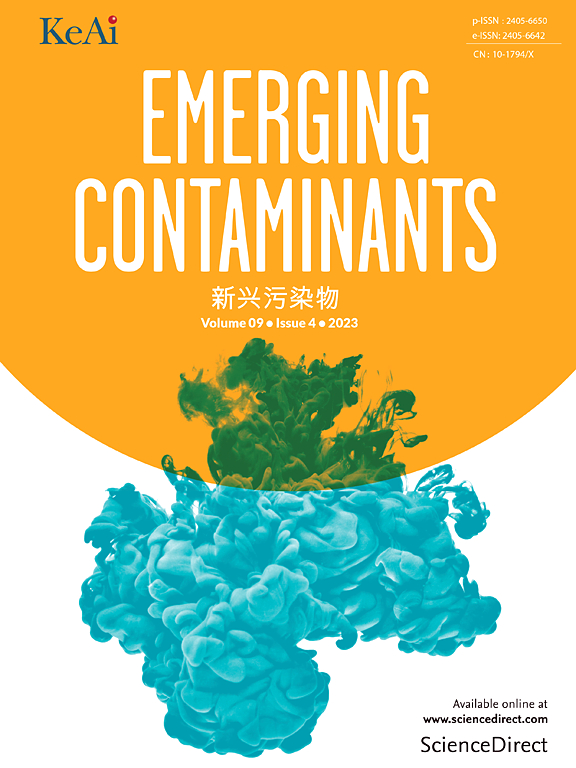印尼Progo河微塑料污染空间分布及其与基于污染指数的水质状况的关系
IF 6.9
2区 环境科学与生态学
Q1 ENVIRONMENTAL SCIENCES
引用次数: 0
摘要
普罗戈河是爪哇岛上最大的河流之一,是爪哇岛中部和印度尼西亚日惹特区清洁用水和灌溉的主要来源。尽管它很重要,但普罗戈河仍是全球塑料污染最严重的20条河流之一。因此,本研究的目的是:(1)调查Progo河微塑料污染的空间分布和特征;(2)研究微塑料与基于Nemerow污染指数(NPI)的水质状况、15个理化生物水质参数、流速和人为因素的关系,这是印度尼西亚首次进行综合研究。同时从8个采样点采集水和MP样品。Progo河的MP丰度在75.02 ~ 435.53颗粒/m3之间。MP的主要特征是大、透明、薄膜状颗粒,可分为LDPE、PET、PP、PS、PAA、玻璃纸等。Pearson相关检验结果显示,MP丰度与9个水质参数(TSS、浊度、盐度、BOD、COD、磷酸盐、硝酸盐、去污剂、Cd)和流速呈正相关。其他6个参数(pH、温度、TDS、DO、总大菌群、Pb)和2个人为因子(种群数量和密度)与MP丰度呈负相关。值得注意的是,DO与MP丰度呈显著负相关(r = -0.770, p = 0.043)。NPI评分(2.10 ~ 16.02)表明Progo河的污染程度为轻度至重度,与MP丰度呈正相关(r=0.336, p=0.461)。多元线性回归分析(R2 = 0.639)表明流速、BOD、COD、浊度、总大肠菌群和种群数量是MP分布的显著预测因子。这些发现强调了多聚氰胺污染对河流水质状况的影响,强调了将多聚氰胺污染纳入定期水质评估以应对生态风险的新方法的必要性。本文章由计算机程序翻译,如有差异,请以英文原文为准。

Spatial distribution of microplastic pollution and its relation to pollution index-based water quality status in Progo River, Indonesia
Progo River, one of the largest rivers on Java Island, serves as the primary source of clean water and irrigation for Central Java and the Special Region of Yogyakarta, Indonesia. Despite its importance, the Progo ranks among the top 20 global plastic-polluted rivers. Therefore, the objectives of this study were 1) to investigate spatial distribution and characteristics of microplastic (MP) pollution in the Progo River, and 2) to examine MP relation to the Nemerow Pollution Index (NPI) based water quality status, 15 physicochemical biological water quality parameters, flow velocity and anthropogenic factors, marking the first comprehensive effort in Indonesia. Water and MP samples were collected simultaneously from eight sampling locations. MP abundance in the Progo River ranged from 75.02 to 435.53 particles/m3. The MP characteristics were predominantly large, transparent, film-shaped particles, and identified variably as LDPE, PET, PP, PS, PAA, cellophane. The Pearson Correlation Test results revealed positive correlations between MP abundance and nine water quality parameters (TSS, turbidity, salinity, BOD, COD, phosphate, nitrate, detergent, Cd) and flow velocity. The other six parameters (pH, temperature, TDS, DO, total coliforms, Pb) and two anthropogenic factors (population number and density) were negatively correlated with MP abundance. Notably, DO exhibited a strong and significant negative correlation with MP abundance (r = -0.770, p = 0.043). NPI scores (2.10–16.02) revealed slight to heavy polluted levels in the Progo River and were positively correlated with MP abundance (r=0.336, p=0.461). Multiple Linear Regression analysis (R2 = 0.639) identified flow velocity, BOD, COD, turbidity, total coliform, and population number as significant predictors of MP distribution. These findings emphasize the impact of MP pollution on river water quality status, highlighting the need of a novel approach to incorporate MP pollution in periodic water quality assessment to address ecological risks.
求助全文
通过发布文献求助,成功后即可免费获取论文全文。
去求助
来源期刊

Emerging Contaminants
Medicine-Public Health, Environmental and Occupational Health
CiteScore
10.00
自引率
6.70%
发文量
35
审稿时长
44 days
期刊介绍:
Emerging Contaminants is an outlet for world-leading research addressing problems associated with environmental contamination caused by emerging contaminants and their solutions. Emerging contaminants are defined as chemicals that are not currently (or have been only recently) regulated and about which there exist concerns regarding their impact on human or ecological health. Examples of emerging contaminants include disinfection by-products, pharmaceutical and personal care products, persistent organic chemicals, and mercury etc. as well as their degradation products. We encourage papers addressing science that facilitates greater understanding of the nature, extent, and impacts of the presence of emerging contaminants in the environment; technology that exploits original principles to reduce and control their environmental presence; as well as the development, implementation and efficacy of national and international policies to protect human health and the environment from emerging contaminants.
 求助内容:
求助内容: 应助结果提醒方式:
应助结果提醒方式:


